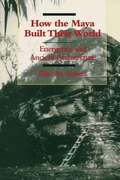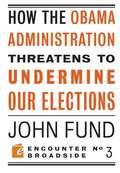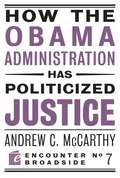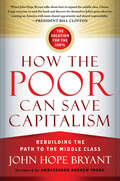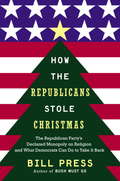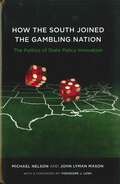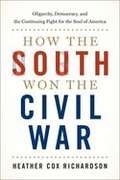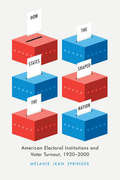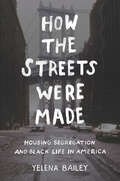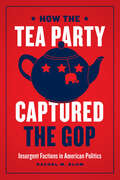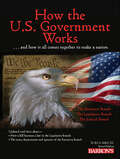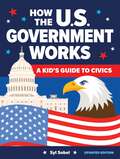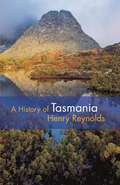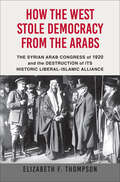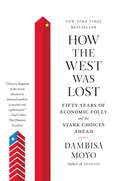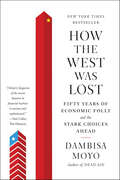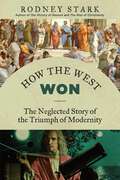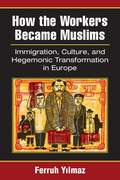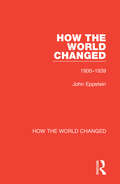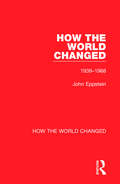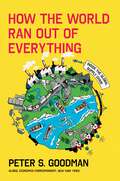- Table View
- List View
How the Maya Built Their World
by Elliot M. AbramsMaya architecture is often described as "massive" and "monumental," but experiments at Copan, Honduras, convinced Elliot Abrams that 300 people could have built one of the large palaces there in only 100 days. In this groundbreaking work, Abrams explicates his theory of architectural energetics, which involves translating structures into volumes of raw and manufactured materials that are then multiplied by the time required for their production and assembly to determine the labor costs of past construction efforts. Applying this method to residential structures of the Late Classic period (A. D. 700-900) at Copan leads Abrams to posit a six-tiered hierarchic social structure of political decision making, ranging from a stratified elite to low-ranking commoners. By comparing the labor costs of construction and other economic activities, he also prompts a reconsideration of the effects of royal construction demands on commoners.
How the Obama Administration Threatens to Undermine Our Elections
by John FundOne of the easiest ways to increase public cynicism about elections is to change the rule book to make the laws governing how we vote more vague and less rigorous. "Reforms" have been passed amid claims they would increase voter turnout. They haven't - but they have made it easier to commit absentee ballot and other fraud.In this explosive broadside, John Fund exposes the new package of reforms being pushed by Obama and liberals in Congress. First, the White House has declared it will exercise oversight of the Census next year, compromising the apportionment of Congressional seats and federal dollars. On top of that, liberals in Congress are pushing for "universal voter registration," a reform that is already used in a half dozen states but has only resulted in serious fraud.Making it easier to vote is a worthy goal. But pushing dubious measures puts the very foundation of our democracy at risk.
How the Obama Administration has Politicized Justice
by Andrew C MccarthyWith the Obama Justice Department under Attorney General Eric Holder's direction, Americans are learning what really happens when law-enforcement power is co-opted by politics.In this eye-popping Broadside, Andrew C. McCarthy shows that the biggest beneficiaries have been jihadists. For the past eight years, a group of lawyers volunteered their services to America's enemies. Now, the Justice Department is rife with some of those same lawyers as it enhances due process for terrorists and feeds the international Left's call for war-crimes charges against President Obama's political adversaries. Just consider how the administration has disclosed national defense secrets during wartime or granted the 9/11 mass murderers a civilian trial. The department, moreover, is working to tighten the Democratic Party's grip on power, ignoring the Constitution and green-lighting election fraud and abuse.
How the Other Half Banks: Exclusion, Exploitation, and the Threat to Democracy
by Mehrsa BaradaranThe United States has two separate banking systems--one serving the well-to-do and another exploiting everyone else. Deserted by banks and lacking credit, many people are forced to wander through a Wild West of payday lenders and check-cashing services thanks to the effects of deregulation in the 1970s that continue today, Mehrsa Baradaran shows.
How the Poor Can Save Capitalism: Rebuilding the Path to the Middle Class
by John Hope BryantJohn Hope Bryant, successful self-made businessman and founder of the nonprofit Operation HOPE, says business and political leaders are ignoring the one force that could truly re-energize the stalled American economy: the poor. If we give poor communities the right tools, policies, and inspiration, he argues, they will be able to lift themselves up into the middle class and become a new generation of customers and entrepreneurs. Raised in poverty-stricken, gang-infested South Central Los Angeles, Bryant saw firsthand how our institutions have abandoned the poor. He details how business loans, home loans, and financial investments have vanished from their communities. After decades of deprivation, the poor lack bank accounts, decent credit scores, and any real firsthand experience of how a healthy free enterprise system functions. Bryant radically redefines the meaning of poverty and wealth. (It's not just a question of finances; it's values too.) He exposes why attempts to aid the poor so far have fallen short and offers a way forward: the HOPE Plan, a series of straightforward, actionable steps to build financial literacy and expand opportunity so that the poor can join the middle class. Fully 70 percent of the American economy is driven by consumer spending, but more and more people have too much month at the end of their money. John Hope Bryant aspires to "expand the philosophy of free enterprise to include all of God's children" and create a thriving economy that works not just for the 1 percent or even the 99 percent but for the 100 percent. This is a free enterprise approach to solving the problem of poverty and raising up a new America.
How the Republicans Stole Christmas
by Bill PressIn the wake of an election seen by many as a triumphant victory for “moral values,” political commentator and one-time seminarian Bill Press launches a counteroffensive against the so-called religious right. For decades, Press argues, conservative preachers such as Jerry Falwell, Pat Robertson, and James Dobson—joined by most Catholic bishops—have defined religion so narrowly that Democrats and liberals have been pushed outside the fold. According to their narrow gospel, God put George Bush in the White House to deal with gays, guns, and abortion—and those who don’t agree are on the sure road to hell. Bill Press says it’s time to take religion back: “Who gave this gang the inside track on religion, anyway? The way I read the Gospels, Jesus was as liberal as Paul Wellstone. He sure as hell wouldn’t have been a registered Republican. One other thing’s for sure: if Jesus ever came back to earth, there’s one gang he wouldn’t hang out with; and that’s this phony bunch of pious, puffed-up preachers who wear religion on their sleeves. ” How the Republicans Stole Christmasis also Press’s fervent call to Democrats and liberals to reclaim religion and return it to its basic principles of social justice, charity, and tolerance. Press argues that the Right didn’t just steal religion, the Left let them have it, offering no resistance as conservatives dictated what’s right and what’s wrong. But on today’s social issues, according to Press, religious conservatives have gotten it all wrong. They have turned Jesus from a loving Messiah who championed the poor and dispossessed into a cold-blooded advocate for the rich and powerful. Press does not confine his criticisms to so-called Christian leaders; he uncovers the same wrong-headed tendencies in other faiths and among nonbelievers, who even today cling to the Old Testament as an appropriate code of behavior. From the Hardcover edition.
How the Republicans Stole Religion: Why the Religious Right is Wrong about Faith & Politics and What We Can Do to Make it Right
by Bill PressFor decades, Press argues, conservatives have defined religion so narrowly that Democrats and liberals have been pushed outside the fold. According to their narrow gospel, God put George W. Bush in the White House to deal with gays, guns, and abortion—and those who don’t agree are on the sure road to hell. How the Republicans Stole Religion is Press’s fervent call for the left to reclaim religion and return it to its basic principles of social justice, charity, and tolerance.
How the Right Lost Its Mind
by Charles J. Sykes"Bracing and immediate." - The Washington PostOnce at the center of the American conservative movement, bestselling author and radio host Charles Sykes is a fierce opponent of Donald Trump and the right-wing media that enabled his rise.In How the Right Lost Its Mind, Sykes presents an impassioned, regretful, and deeply thoughtful account of how the American conservative movement came to lose its values. How did a movement that was defined by its belief in limited government, individual liberty, free markets, traditional values, and civility find itself embracing bigotry, political intransigence, demagoguery, and outright falsehood? How the Right Lost its Mind addresses:*Why are so many voters so credulous and immune to factual information reported by responsible media?*Why did conservatives decide to overlook, even embrace, so many of Trump’s outrages, gaffes, conspiracy theories, falsehoods, and smears?*Can conservatives govern? Or are they content merely to rage?*How can the right recover its traditional values and persuade a new generation of their worth?
How the South Joined the Gambling Nation: The Politics of State Policy Innovation
by Michael Nelson Theodore J. Lowi John Lyman MasonA national map of legalized gambling from 1963 would show one state, Nevada, with casino gambling and no states with lotteries. Today's map shows eleven commercial casino states, most of them along the Mississippi River, forty-two states with state-owned lotteries, and racetrack betting, slot-machine parlors, charitable bingo, and Native American gambling halls flourishing throughout the nation. For the past twenty years, the South has wrestled with gambling issues. In How the South Joined the Gambling Nation, Michael Nelson and John Lyman Mason examine how modern southern state governments have decided whether to adopt or prohibit casinos and lotteries. Nelson and Mason point out that although the South participated fully in past gambling eras, it is the last region to join the modern movement embracing legalized gambling. Despite the prevalence of wistful, romantic images of gambling on southern riverboats, the politically and religiously conservative ideology of the modern South makes it difficult for states to toss their chips into the pot.The authors tell the story of the arrival or rejection of legalized gambling in seven southern states -- Mississippi, Louisiana, Tennessee, South Carolina, Georgia, Arkansas, and Alabama. The authors suggest that some states chose to legalize gambling based on the examples of other nearby states, as when Mississippi casinos spurred casino legalization in Louisiana and the Georgia lottery inspired lottery campaigns in neighboring South Carolina, Alabama, and Tennessee. Also important was the influence of Democratic policy entrepreneurs, such as Zell Miller in Georgia, Don Siegelman in Alabama, and Edwin Edwards in Louisiana, who wanted to sell the idea of gambling in order to sell themselves to voters. At the same time, each state had its own idiosyncrasies, such as certain provisions of their state constitutions weighing heavily as a factor.Nelson and Mason show that the story of gambling's spread in the South exemplifies the process of state policy innovation. In exploring how southern states have weighed the moral and economic risk of legalizing gambling, especially the political controversies that surround these discussions, Nelson and Mason employ a suspenseful, fast-paced narrative that echoes the oftentimes hurried decisions made by state legislators. Although each of these seven states fought a unique battle over gambling, taken together, these case studies help tell the larger story of how the South -- sometimes reluctantly, sometimes enthusiastically -- decided to join the gambling nation.
How the South Won the Civil War: Oligarchy, Democracy, and the Continuing Fight for the Soul of America
by Heather Cox RichardsonThis book is named one of The Washington Post's 50 Notable Works of Nonfiction. Heather Cox Richardson argues in this provocative work that democracy's blood-soaked victory was ephemeral. The system that had sustained the defeated South moved westward and there established a foothold. It was a natural fit. Settlers from the East had for decades been pushing into the West, where the seizure of Mexican lands at the end of the Mexican-American War and treatment of Native Americans cemented racial hierarchies. The South and West equally depended on extractive industries-cotton in the former and mining, cattle, and oil in the latter-giving rise a new birth of white male oligarchy, despite the guarantees provided by the 13th, 14th, and 15th Amendments, and the economic opportunities afforded by expansion. To reveal why this happened, How the South Won the Civil War traces the story of the American paradox, the competing claims of equality and subordination woven into the nation's fabric and identity.
How the States Shaped the Nation: American Electoral Institutions and Voter Turnout, 1920-2000
by Melanie Jean SpringerThe United States routinely has one of the lowest voter turnout rates of any developed democracy in the world. That rate is also among the most internally diverse, since the federal structure allows state-level variations in voting institutions that have had--and continue to have--sizable local effects. But are expansive institutional efforts like mail-in registration, longer poll hours, and "no-excuse" absentee voting uniformly effective in improving voter turnout across states? With "How the States Shaped the Nation, " Melanie Jean Springer places contemporary reforms in historical context and systematically explores how state electoral institutions have been instrumental in shaping voting behavior throughout the twentieth century. Although reformers often assume that more convenient voting procedures will produce equivalent effects wherever they are implemented, Springer reveals that this is not the case. In fact, convenience-voting methods have had almost no effect in the southern states where turnout rates are lowest. In contrast, the adverse effects associated with restrictive institutions like poll taxes and literacy tests have been persistent and dramatic. Ultimately, Springer argues, no single institutional fix will uniformly resolve problems of low or unequal participation. If we want to reliably increase national voter turnout rates, we must explore how states' voting histories differ and better understand the role of political and geographical context in shaping institutional effects.
How the Streets Were Made: Housing Segregation and Black Life in America
by Yelena BaileyIn this book, Yelena Bailey examines the creation of "the streets" not just as a physical, racialized space produced by segregationist policies but also as a sociocultural entity that has influenced our understanding of blackness in America for decades. Drawing from fields such as media studies, literary studies, history, sociology, film studies, and music studies, this book engages in an interdisciplinary analysis of the how the streets have shaped contemporary perceptions of black identity, community, violence, spending habits, and belonging. Where historical and sociological research has examined these realities regarding economic and social disparities, this book analyzes the streets through the lens of marketing campaigns, literature, hip-hop, film, and television in order to better understand the cultural meanings associated with the streets. Because these media represent a terrain of cultural contestation, they illustrate the way the meaning of the streets has been shaped by both the white and black imaginaries as well as how they have served as a site of self-assertion and determination for black communities.
How the Tea Party Captured the GOP: Insurgent Factions in American Politics
by Rachel M. BlumThis incisive and timely study of American party politics reveals how a fringe group within the Republican party came to wield outsized power.The rise of the Tea Party redefined both the Republican Party and how we think about intraparty conflict. What initially appeared to be an anti-Obama protest movement of fiscal conservatives matured into a faction that sought to increase its influence in the Republican Party by any means necessary. Tea Partiers captured the party’s organizational machinery and used it to replace established politicians with Tea Party–style Republicans, eventually laying the groundwork for the nomination and election of a candidate like Donald Trump.In How the Tea Party Captured the GOP, Rachel Marie Blum offers a novel theory of political party factions, framing them as miniature parties within parties. Using this framework, she demonstrates how fringe groups can leverage factions to increase their political influence in the American two-party system. In this richly researched book, Blum uncovers how the electoral losses of 2008 sparked disgruntled Republicans to form the Tea Party faction, and the strategies the Tea Party used to wage a systematic takeover of the Republican Party. This book not only illuminates how the Tea Party achieved its influence, but also provides a blueprint for identifying other factional insurgencies.
How the U. S. Government Works
by Syl SobelA fine classroom supplement and a solid information source for kids writing social studies reports, this updated, easy-to-read book explains the federal system as it works in the United States today. It also discusses some ways in which the government has changed since the framers of the Constitution brought it into existence in the 18th century. Described are the Legislative body, composed of Senate and House of Representatives, the Executive branch, headed by the President with the Cabinet members, and the Judicial branch, headed by the Supreme Court of the United States, and extending to federal courts throughout the nation. New in this edition are facts about how a bill becomes a law, the various departments in the Executive branch, and more. Young readers learn how officials are elected or appointed and how government agencies work for the people's benefit. A complex process is explained in interesting terms that young readers can comprehend.
How the U.S. Government Works: ...and how it all comes together to make a nation
by Syl Sobel J.D.This updated, easy-to-read book about the United States for kids explains the federal system as it works today. It also discusses why the framers of the Constitution created the U.S. government in the 18th century and the purposes it was designed to serve.Parents, teachers, and gift givers will find:an easy-to-read book about a complex subject revised for the classroom and homecurriculum aligned vocabulary, expanded glossary, discussion questions, and resource guideinformation on how presidents and other officials are elected or appointedDescribed are the Legislative branch, composed of the Senate and the House of Representatives; the Executive branch, headed by the President with the Cabinet members; and the Judicial branch, comprised of the Supreme Court of the United States and the lower federal courts throughout the nation.
How the U.S. Government Works: A Kid's Guide to Civics
by Syl Sobel J.D.Newly updated edition!Discover everything you need to know about American democracy with this easy-to-read guide to our government!How the U.S. Government Works is a fact-packed primer that helps kids understand the many facets of America's federal system. Readers will learn about how the government came to be, the responsibilities of the Executive, Legislative, and Judicial branches, and how our democracy impacts their own lives today!
How the Weak Win Wars: A Theory of Asymmetric Conflict
by Ivan Arreguín-ToftHow do the weak defeat the strong? Ivan Arreguín-Toft argues that, although many factors affect asymmetric conflict outcomes (for example, the relative power of the actors, their weapons technology, and outside support), the interaction of each actor's strategy is the best explanation. Supporting his argument with combined statistical and comparative case study analysis, Arreguín-Toft's strategic interaction theory has implications not only for international relations theorists, but for policy makers grappling with interstate and civil wars, as well as terrorism.
How the West Stole Democracy from the Arabs: The Syrian Arab Congress of 1920 and the Destruction of Its Historical Liberal-Islamic Alliance
by Elizabeth F. Thompson“This expertly researched account brings to life a meaningful but underexplored chapter in world history.” —Publishers WeeklyWhen Europe’s Great War engulfed the Ottoman Empire, Arab nationalists rose in revolt against the Turks. The British supported the Arabs’ fight for an independent state and sent an intelligence officer, T.E. Lawrence, to join Prince Faisal, leader of the Arab army and a descendant of the Prophet. In October 1918, Faisal, Lawrence, and the Arabs victoriously entered Damascus, where they declared a constitutional government in an independent Greater Syria.At the Paris Peace Conference, Faisal won the support of Woodrow Wilson, who sent an American commission to Syria to survey the political aspirations of its people. However, other Entente leaders at Paris—and later San Remo—schemed against the Arab democracy, which they saw as a threat to their colonial rule. On March 8, 1920, the Syrian-Arab Congress declared independence and crowned Faisal king of a “representative monarchy.” Rashid Rida, a leading Islamic thinker of the day, led the constituent assembly to establish equality for all citizens, including non-Muslims, under a full bill of rights.But France and Britain refused to recognize the Damascus government, instead imposing a system of mandates on the Arab provinces of the defeated Ottoman Empire, on the pretext that Arabs weren’t yet ready for self-government. Under such a mandate, the French invaded Syria in April, crushing the Arab government and sending Faisal and Congress leaders into exile. The fragile coalition of secular modernizers and Islamic reformers that might have established democracy in the Arab world was destroyed, with profound consequences that reverberate still.Using many previously untapped primary sources, including contemporary newspaper accounts and letters, minutes from the Syrian-Arab Congress, and diary and journal entries from participants, How The West Stole Democracy From The Arabs is a groundbreaking account of this extraordinary, brief moment of unity and hope—and of its destruction.“Important and fascinating.” —Amaney A. Jamal, Edwards S. Sanford Professor of Politics, Princeton University
How the West Was Lost
by Dambisa MoyoA bold account of the decline of the West's economic supremacy and radical solutions to reverse the drift.Bestselling author Dambisa Moyo gives a fresh insider's perspective on the erosion of Western power over the past 50 years. She examines how the West's flawed financial decisions and blinkered political and military choices have resulted in an economic and geopolitical seesaw that is now poised to favour the emerging world.Moyo is uniquely positioned to examine the West's errors and the techniques the emerging countries used to rise on the global economic stage:As a former economist and banker she gives a new perspective on the dramatic shifts in the global economyHer "Wall Street" vantage point captures the nuances of what role the financial sector had in the decline of Western powerHer world view as someone neither from the West nor from any of the emerging countries produces an unbiased, non-Western analysisMoyo daringly claims that the West can no longer afford to regard the up-and-comers simply as menacing gatecrashers and proposes radical solutions it needs to adopt in order to reassert itself as a global economic power.
How the West Was Lost: Fifty Years of Economic Folly and the Stark Choices Ahead
by Dambisa MoyoIn How the West Was Lost, the New York Times bestselling author Dambisa Moyo offers a bold account of the decline of the West's economic supremacy. She examines how the West's flawed financial decisions have resulted in an economic and geopolitical seesaw that is now poised to tip in favor of the emerging world, especially China. Amid the hype of China's rise, however, the most important story of our generation is being pushed aside: America is not just in economic decline, but on course to become the biggest welfare state in the history of the West. The real danger is at home, Moyo claims. While some countries – such as Germany and Sweden – have deliberately engineered and financed welfare states, the United States risks turning itself into a bloated welfare state not because of ideology or a larger vision of economic justice, but out of economic desperation and short-sighted policymaking.How the West Was Lost reveals not only the economic myopia of the West but also the radical solutions that it needs to adopt in order to assert itself as a global economic power once again.
How the West Won: The Neglected Story of the Triumph of Modernity
by Rodney StarkFinally the Truth about the Rise of the West Modernity developed only in the West—in Europe and North America. Nowhere else did science and democracy arise; nowhere else was slavery outlawed. Only Westerners invented chimneys, musical scores, telescopes, eyeglasses, pianos, electric lights, aspirin, and soap. The question is, Why? Unfortunately, that question has become so politically incorrect that most scholars avoid it. But acclaimed author Rodney Stark provides the answers in this sweeping new look at Western civilization. How the West Won demonstrates the primacy of uniquely Western ideas—among them the belief in free will, the commitment to the pursuit of knowledge, the notion that the universe functions according to rational rules that can be discovered, and the emphasis on human freedom and secure property rights. Taking readers on a thrilling journey from ancient Greece to the present, Stark challenges much of the received wisdom about Western history. Stark also debunks absurd fabrications that have flourished in the past few decades: that the Greeks stole their culture from Africa; that the West&’s &“discoveries&” were copied from the Chinese and Muslims; that Europe became rich by plundering the non-Western world. At the same time, he reveals the woeful inadequacy of recent attempts to attribute the rise of the West to purely material causes—favorable climates, abundant natural resources, guns and steel. How the West Won displays Rodney Stark&’s gifts for lively narrative history and making the latest scholarship accessible to all readers. This bold, insightful book will force you to rethink your understanding of the West and the birth of modernity—and to recognize that Western civilization really has set itself apart from other cultures.
How the Workers Became Muslims: Immigration, Culture, and Hegemonic Transformation in Europe
by Ferruh YilmazWriting in the beginning of the 1980s, Ernesto Laclau and Chantal Mouffe explored possibilities for a new socialist strategy to capitalize on the period's fragmented political and social conditions. Two and a half decades later, Ferruh Yilmaz acknowledges that the populist Far Right-not the socialist movement-has demonstrated greater facility in adopting successful hegemonic strategies along new structural lines Laclau and Mouffe imagined. Right-wing hegemonic strategy, Yilmaz argues, has led to the reconfiguration of internal fault lines in European societies. Yilmaz's primary case study is Danish immigration discourse, but his argument contextualizes his study in terms of questions of current concern across Europe, where right-wing groups that were long on the fringes of "legitimate" politics have managed to make significant gains with populations traditionally aligned with the Left. Specifically, Yilmaz argues that sociopolitical space has been transformed in the last three decades such that group classification has been destabilized to emphasize cultural rather than economic attributes. According to this point-of-view, traditional European social and political splits are jettisoned for new "cultural" alliances pulling the political spectrum to the right, against the "corrosive" presence of Muslim immigrants, whose own social and political variety is flattened into an illusion of alien sameness. Book jacket.
How the World Changed: Volume 1 1900-1939 (How the World Changed)
by John EppsteinFirst published in 1969, How the World Changed: Volume 1 1900-1939 is the first of two volumes that together outline the political history of the twentieth century up to 1968. This volume extends from 1900-1939 and explores life prior to, during, and after the First World War. In doing so, it covers significant political events and features of the period, including the Chinese Revolution and the rise of Japan, the different stages of the First World War, the peace process, the Russian Revolution, economic challenges, and the British Empire and Commonwealth.
How the World Changed: Volume 2 1939-1968 (How the World Changed)
by John EppsteinFirst published in 1969, How the World Changed: Volume 2 1939-1968 is the second of two volumes that together outline the political history of the twentieth century up to 1968. This volume covers the period from 1939-1968 and examines the history and politics of the Second World War and the state of the world in the years that followed it, including economic recovery, Soviet expansion, the Chinese People’s Republic, and shifts in world power.
How the World Ran Out of Everything: Inside the Global Supply Chain
by Peter S. GoodmanBy the New York Times’s Global Economics Correspondent, an extraordinary journey to understand the worldwide supply chain—exposing both the fascinating pathways of manufacturing and transportation that bring products to your doorstep, and the ruthless business logic that has left local communities at the mercy of a complex and fragile network for their basic necessities."A tale that will change how you look at the world." —Mark LeibovichOne of Foreign Policy's "Most Anticipated Books of 2024"How does the wealthiest country on earth run out of protective gear in the middle of a public health catastrophe? How do its parents find themselves unable to locate crucially needed infant formula? How do its largest companies spend billions of dollars making cars that no one can drive for a lack of chips?The last few years have radically highlighted the intricacy and fragility of the global supply chain. Enormous ships were stuck at sea, warehouses overflowed, and delivery trucks stalled. The result was a scarcity of everything from breakfast cereal to medical devices, from frivolous goods to lifesaving necessities. And while the scale of the pandemic shock was unprecedented, it underscored the troubling reality that the system was fundamentally at risk of descending into chaos all along. And it still is. Sabotaged by financial interests, loss of transparency in markets, and worsening working conditions for the people tasked with keeping the gears turning, our global supply chain has become perpetually on the brink of collapse.In How the World Ran Out of Everything, award-winning journalist Peter S. Goodman reveals the fascinating innerworkings of our supply chain and the factors that have led to its constant, dangerous vulnerability. His reporting takes readers deep into the elaborate system, showcasing the triumphs and struggles of the human players who operate it—from factories in Asia and an almond grower in Northern California, to a group of striking railroad workers in Texas, to a truck driver who Goodman accompanies across hundreds of miles of the Great Plains. Through their stories, Goodman weaves a powerful argument for reforming a supply chain to become truly reliable and resilient, demanding a radical redrawing of the bargain between labor and shareholders, and deeper attention paid to how we get the things we need.From one of the most respected economic journalists working today, How the World Ran Out of Everything is a fiercely smart, deeply informative look at how our supply chain operates, and why its reform is crucial—not only to avoid dysfunction in our day to day lives, but to protect the fate of our global fortunes.
